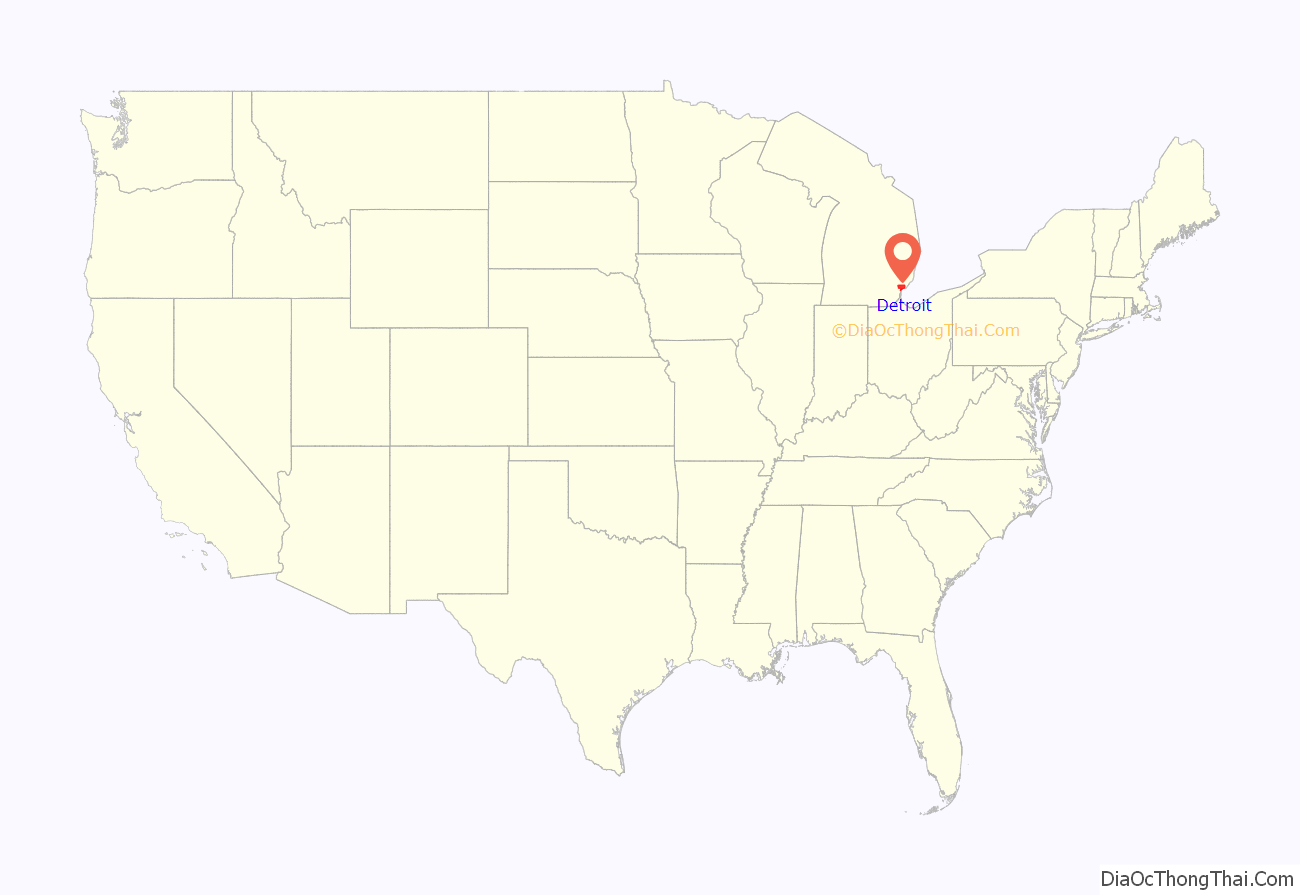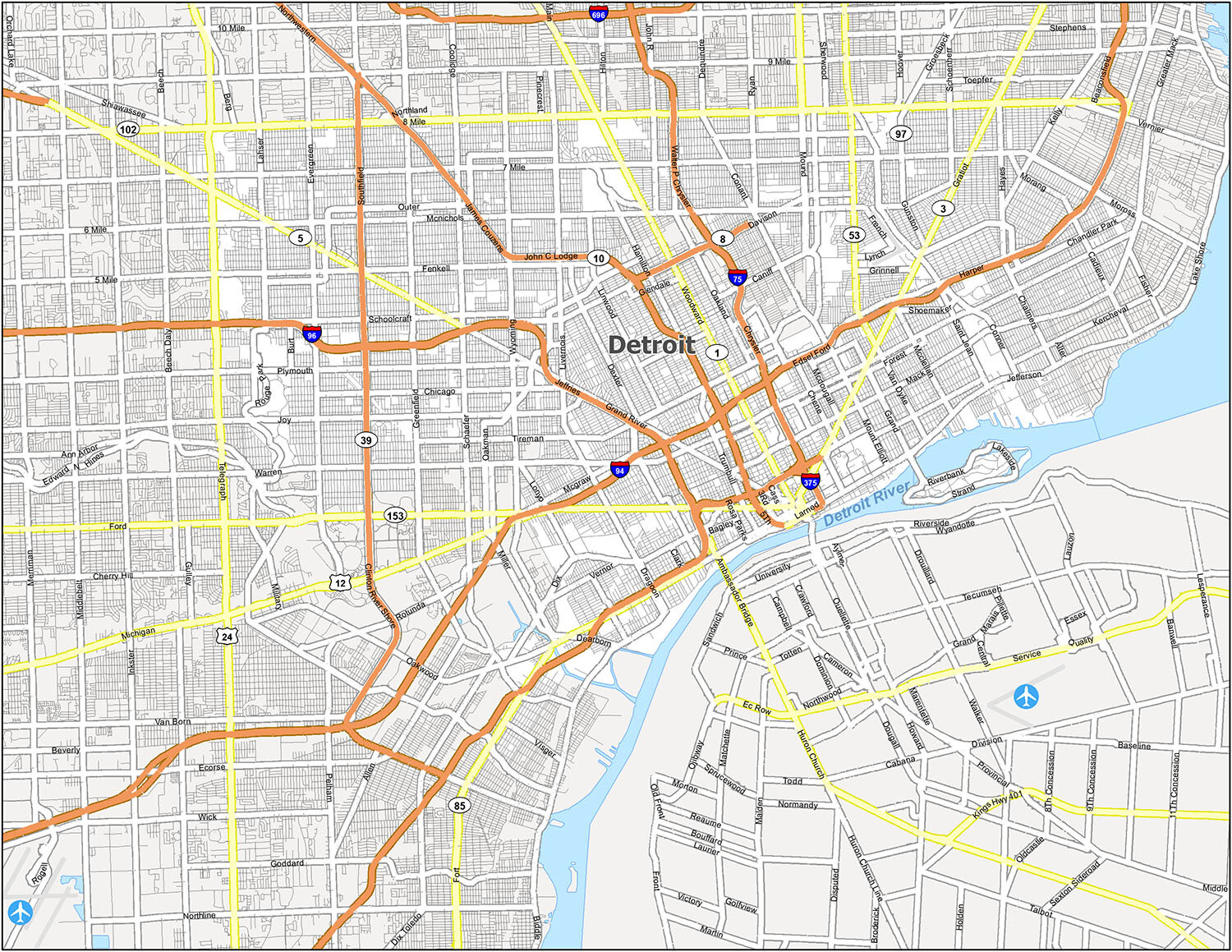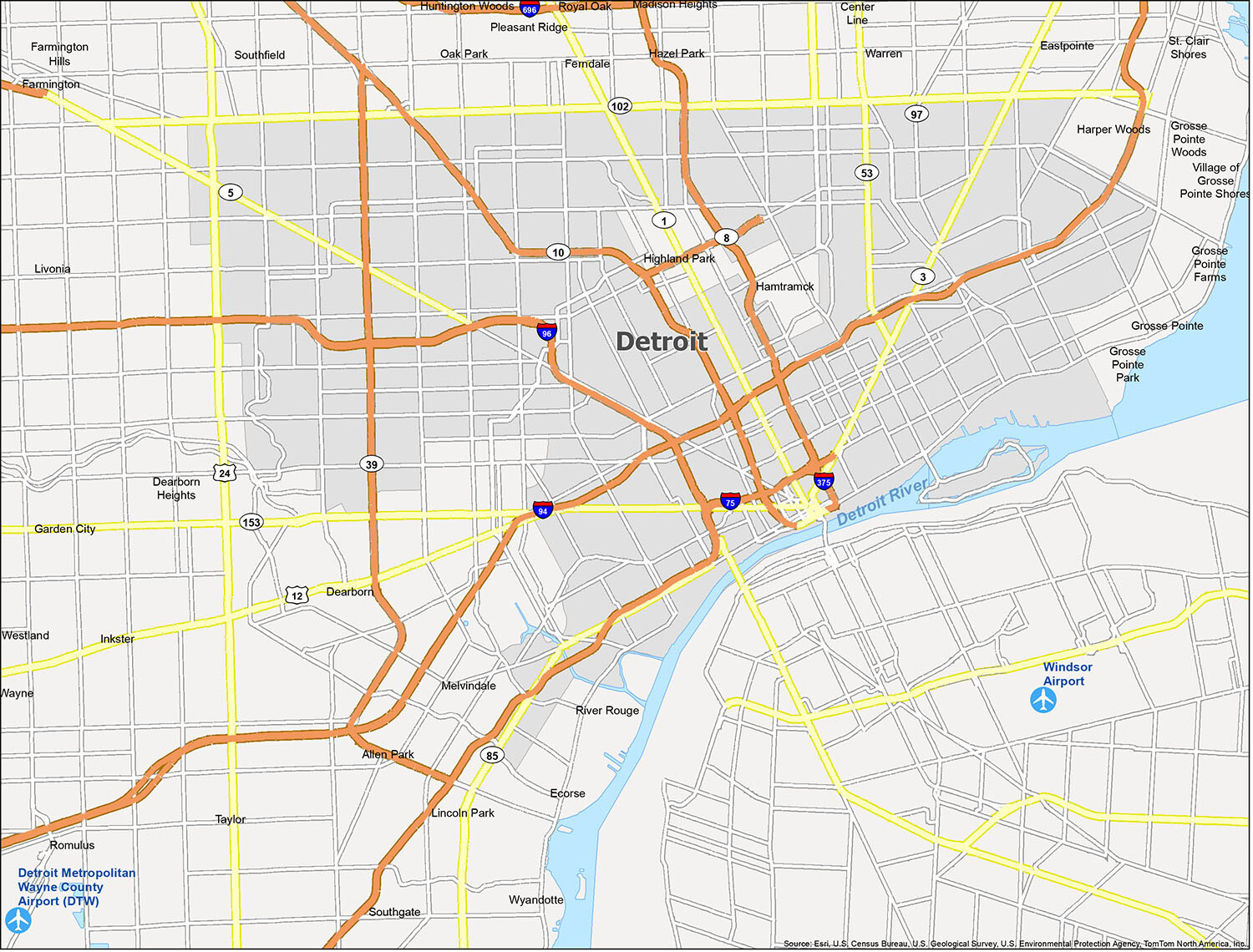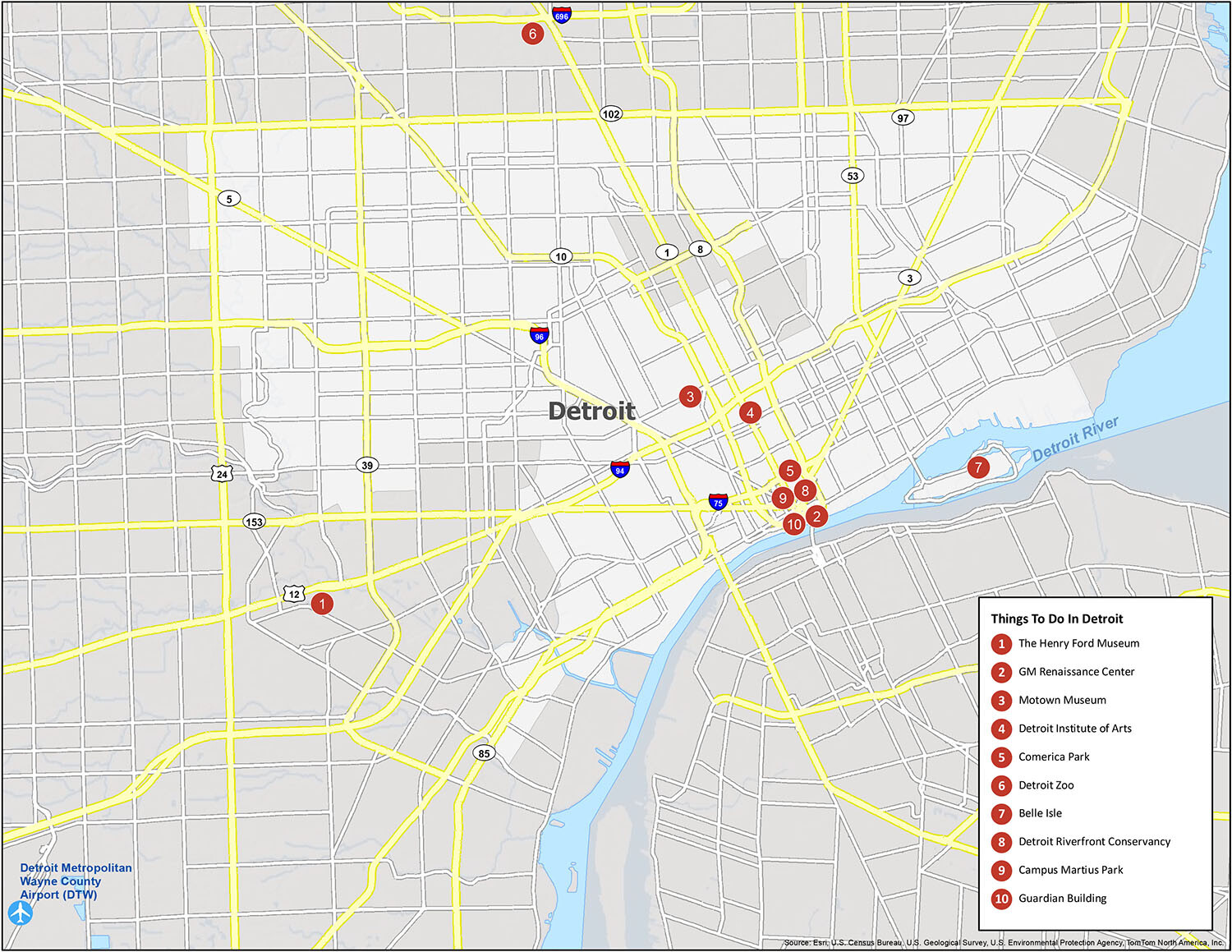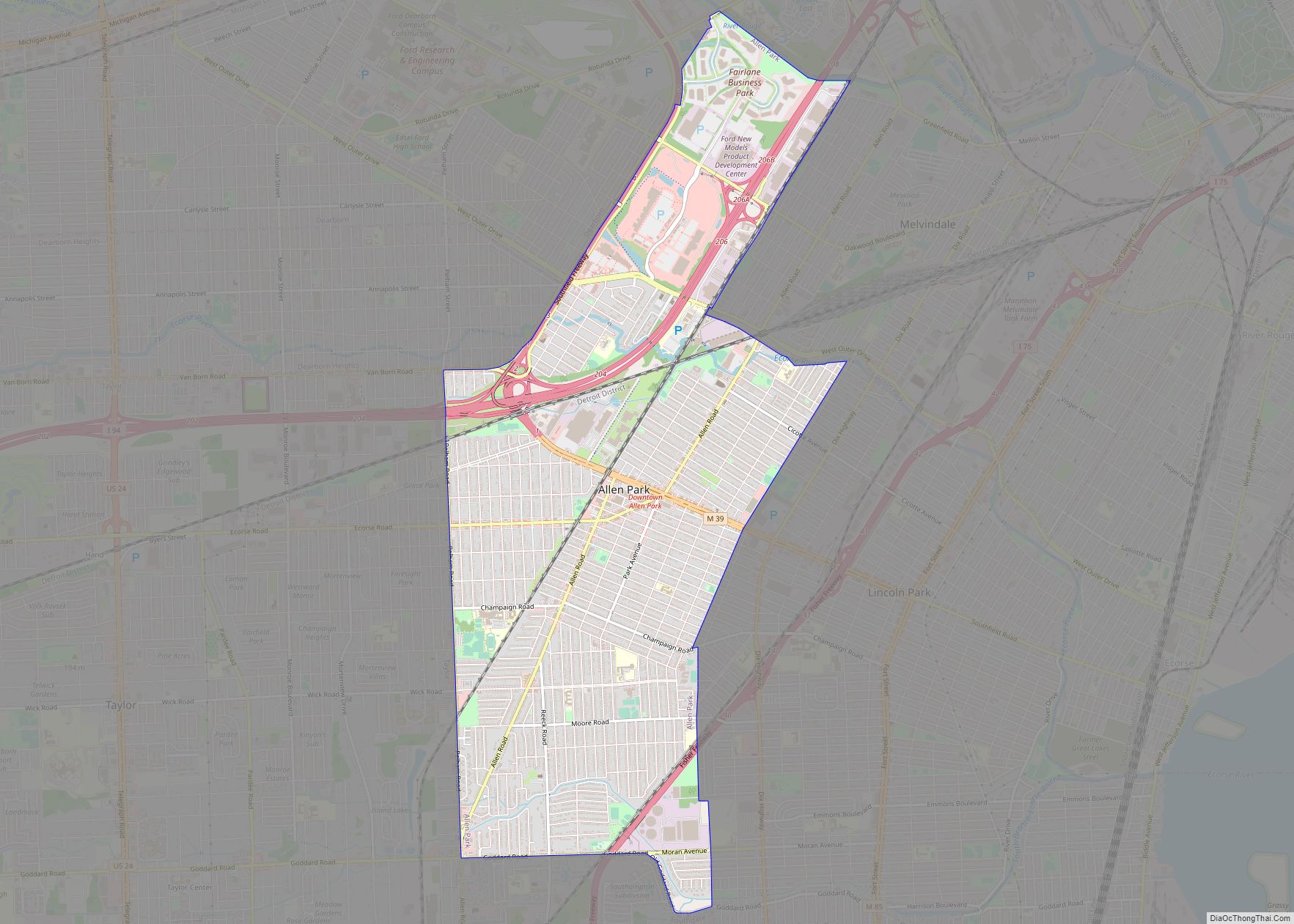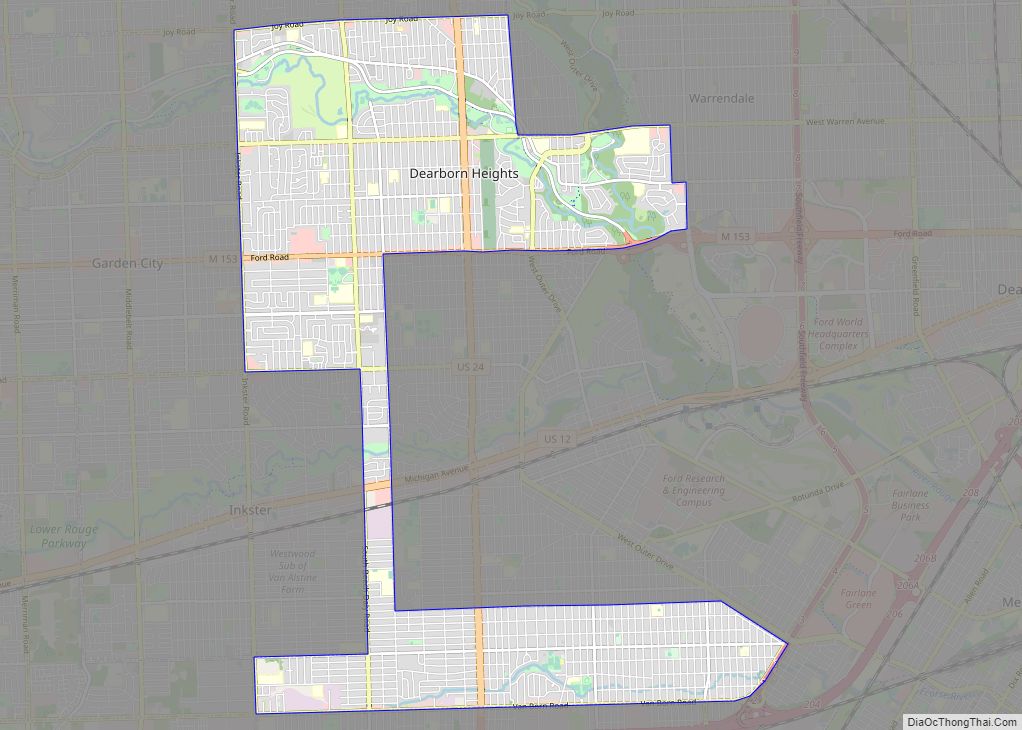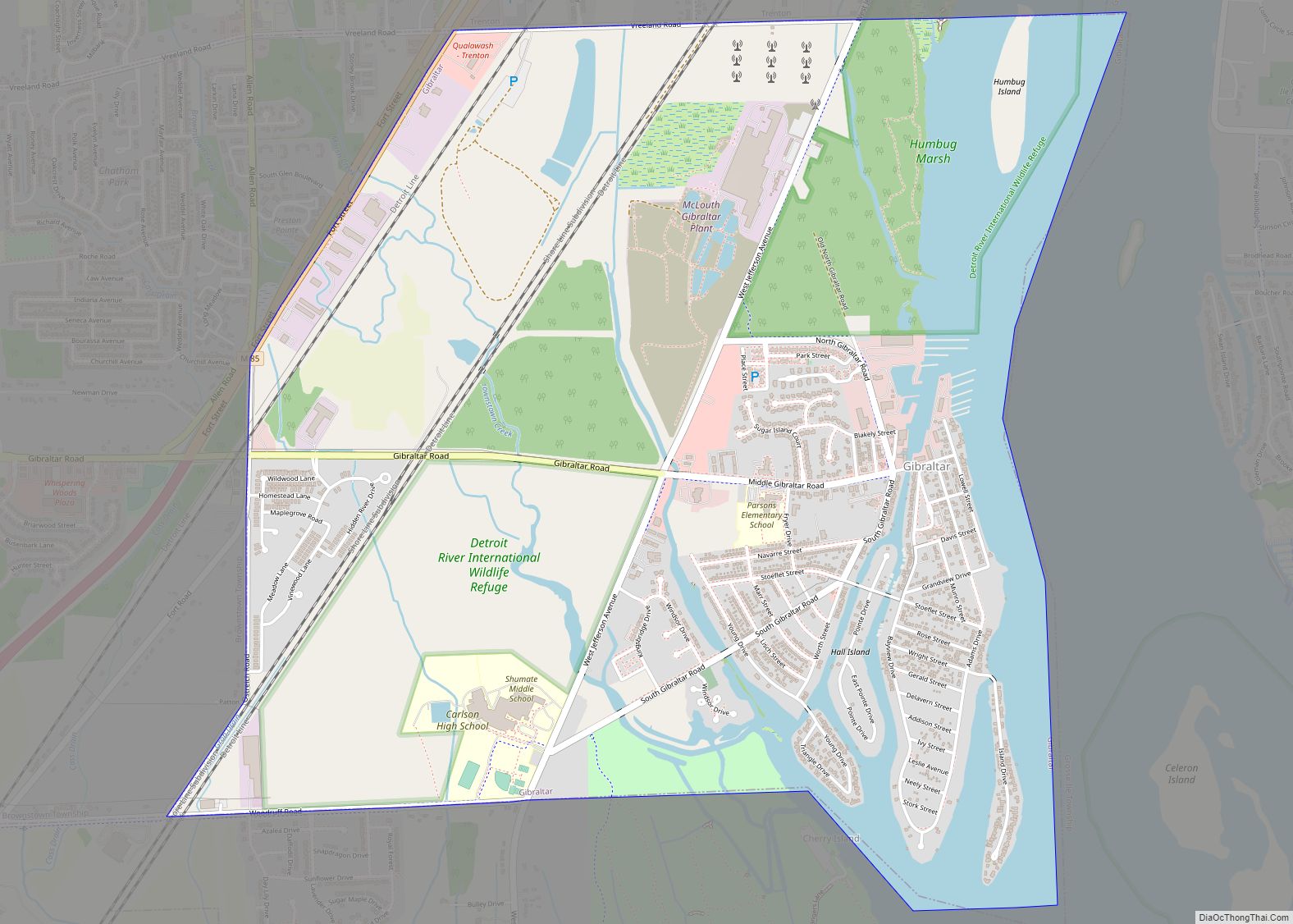Detroit (/dəˈtrɔɪt/ də-TROYT, locally also /ˈdiːtrɔɪt/ DEE-troyt) is the largest city in the U.S. state of Michigan. It is also the largest U.S. city on the United States–Canada border, and the seat of government of Wayne County. The City of Detroit had a population of 639,111 at the 2020 census, making it the 27th-most populous city in the United States. The metropolitan area, known as Metro Detroit, is home to 4.3 million people, making it the second-largest in the Midwest after the Chicago metropolitan area, and the 14th-largest in the United States. Regarded as a major cultural center, Detroit is known for its contributions to music, art, architecture and design, in addition to its historical automotive background. Time named Detroit as one of the fifty World’s Greatest Places of 2022 to explore.
Detroit is a major port on the Detroit River, one of the four major straits that connect the Great Lakes system to the Saint Lawrence Seaway. The City of Detroit anchors the third-largest regional economy in the Midwest, behind Chicago and Minneapolis–Saint Paul, and the 16th-largest in the United States. Detroit is best known as the center of the U.S. automobile industry, and the “Big Three” auto manufacturers General Motors, Ford, and Stellantis North America (Chrysler) are all headquartered in Metro Detroit. As of 2007, the Detroit metropolitan area is the number one exporting region among 310 defined metropolitan areas in the United States. The Detroit Metropolitan Airport is among the most important hub airports in the United States. Detroit and its neighboring Canadian city Windsor are connected through a highway tunnel, railway tunnel, and the Ambassador Bridge, which is the second-busiest international crossing in North America, after San Diego–Tijuana. Both cities will soon be connected by a new bridge currently under construction, the Gordie Howe International Bridge, which will provide a complete freeway-to-freeway link. The new bridge is expected to be open by 2024.
In 1701, Antoine de la Mothe Cadillac and Alphonse de Tonty founded Fort Pontchartrain du Détroit, the future city of Detroit. During the late nineteenth and early twentieth century, it became an important industrial hub at the center of the Great Lakes region. The city’s population became the fourth-largest in the nation in 1920, after only New York City, Chicago and Philadelphia, with the expansion of the auto industry in the early 20th century. As Detroit’s industrialization took off, the Detroit River became the busiest commercial hub in the world. The strait carried over 65 million tons of shipping commerce through Detroit to locations all over the world each year; the freight throughput was more than three times that of New York and about four times that of London. By the 1940s, the city’s population remained the fourth-largest in the country. However, due to industrial restructuring, the loss of jobs in the auto industry, and rapid suburbanization, among other reasons, Detroit entered a state of urban decay and lost considerable population from the late 20th century to the present. Since reaching a peak of 1.85 million at the 1950 census, Detroit’s population has declined by more than 65 percent. In 2013, Detroit became the largest U.S. city to file for bankruptcy, which it successfully exited in December 2014, when the city government regained control of Detroit’s finances.
Detroit’s diverse culture has had both local and international influence, particularly in music, with the city giving rise to the genres of Motown and techno, and playing an important role in the development of jazz, hip-hop, rock, and punk. The rapid growth of Detroit in its boom years resulted in a globally unique stock of architectural monuments and historic places. Since the 2000s, conservation efforts have managed to save many architectural pieces and achieved several large-scale revitalizations, including the restoration of several historic theaters and entertainment venues, high-rise renovations, new sports stadiums, and a riverfront revitalization project. More recently, the population of Downtown Detroit, Midtown Detroit, and various other neighborhoods have increased. An increasingly popular tourist destination, Detroit receives 16 million visitors per year. In 2015, Detroit was named a “City of Design” by UNESCO, the first U.S. city to receive that designation.
| Name: | Detroit city |
|---|---|
| LSAD Code: | 25 |
| LSAD Description: | city (suffix) |
| State: | Michigan |
| County: | Wayne County |
| Founded: | July 24, 1701 (1701-07-24) |
| Incorporated: | September 13, 1806 (1806-09-13) |
| Elevation: | 656 ft (200 m) |
| Land Area: | 138.73 sq mi (359.31 km²) |
| Water Area: | 4.16 sq mi (10.78 km²) |
| Population Density: | 4,606.84/sq mi (1,778.71/km²) |
| Area code: | 313 |
| FIPS code: | 2622000 |
| GNISfeature ID: | 1617959 |
| Website: | www.detroitmi.gov |
Discover the Motor City with this collection of maps of Detroit.
Explore the city of Detroit with this collection of maps. From the world-famous Detroit Institute of Arts to the innovative Henry Ford museum, get to know the Motor City and its landmarks, highways/roads, and places of reference. Interactively explore the city with the Google Map below and discover all that Detroit has to offer.
Online Interactive Map
Click on ![]() to view map in "full screen" mode.
to view map in "full screen" mode.
This interactive map is detailed and easy to use. It includes information about the city’s top attractions along with where to stay and where to eat. There are also a variety of parks and hiking trails throughout the city and on the outskirts. The city is located on the Detroit River and the massive Lake St. Clair to the northeast. It’s also the home to several sports teams like the Tigers (baseball), Lions (football), Pistons (basketball), and the Red Wings (hockey).
Detroit location map. Where is Detroit city?
Detroit Road Map
Detroit is a major transportation hub, and home to several major companies, including General Motors, Ford, and Chrysler. No more getting lost in the Motor City with this printable map of the city. This map will help you navigate your way through the city offering a bird’s eye view of its interstates, highways, and major roads. Use this map to plan your vacation to visit Motor City or make sure to use our road map of Michigan if you’re driving in the state.
Interstate Highways: I-75, I-94, I-96, I-375
US Highways: 3, 5, 8, 10, 12, 24, 39, 53, 85, 102, 153, Vernor Hwy, Schaefer Hwy, Detroit Windsor Tunnel
Parkways/Freeways: Edsel Ford Fwy, Fisher Fwy, James Couzens Fwy, Jeffries Fwy, John C Lodge Expy, John C Lodge Fwy, Southfield Fwy, Walter P Chrysler Fwy
Major Roads: 5th St, 8 Mile Rd, Ambassador Bridge, Cadillac Blvd, Cass Ave, Chrysler Dr, Clark St, Conner St, Davison St, Dragoon St, Evergreen Rd, Fenkell St, Ford Rd, Forest Ave, Grand River Ave, Gratiot Ave, Greenfield Rd, Harper Ave, Jefferson Ave, Lafayette Blvd, Livernois St, McGraw St, McNichols Rd, Michigan Ave, Monroe St, Mound Rd, Mount Elliott St, Oakwood Blvd, Porter St, Randolph St, Telegraph Rd, Van Dyke St, Warren Ave, Woodward Ave
Detroit is a city of diverse neighborhoods and attractions, from historical homes to modern lofts. The city also has a thriving arts community and a number of museums and cultural institutions. Visitors and locals alike can explore the spirit of Detroit by getting the chance to meet new people and learn about the culture of America.
When you visit Detroit, you can fly into the Detroit Metropolitan Wayne County Airport (DTW), and explore the nearby cities of Allen Park, Center Line, Dearborn, Dearborn Heights, Eastpointe, Ecorse, Farmington, Farmington Hills, Ferndale, Garden City, Grosse Pointe, Grosse Pointe Farms, Grosse Pointe Park, Grosse Pointe Woods, Hamtramck, Harper Woods, Hazel Park, Highland Park, Huntington Woods, Inkster, Lincoln Park, Livonia, Madison Heights, Melvindale, Oak Park, Pleasant Ridge, River Rouge, Romulus, Royal Oak, Southfield, Southgate, St. Clair Shores, Taylor, Village of Grosse Pointe Shores, Warren, Wayne, Westland, and Wyandotte.
10 things to do in Detroit city
The Detroit metropolitan area is an important part of Michigan and the Midwest. It boasts a vibrant art scene and plenty of attractions to keep you busy. From the Henry Ford Museum to the Detroit Institute of Arts, there’s something for everyone in the Motor City. Use this Detroit Map as your guide to the city and some of its major attractions. It includes popular parks, museums, and other places of interest to explore.
Detroit city Satellite Map
Geography
Metropolitan area
Detroit is the center of a three-county urban area (with a population of 3,734,090 within an area of 1,337 square miles (3,460 km) according to the 2010 United States Census), six-county metropolitan statistical area (population of 4,296,250 in an area of 3,913 square miles [10,130 km] as of the 2010 census), and a nine-county Combined Statistical Area (population of 5.3 million within 5,814 square miles [15,060 km] as of 2010).
Topography
According to the U.S. Census Bureau, the city has a total area of 142.87 square miles (370.03 km), of which 138.75 square miles (359.36 km) is land and 4.12 square miles (10.67 km) is water. Detroit is the principal city in Metro Detroit and Southeast Michigan. It is situated in the Midwestern United States and the Great Lakes region.
The Detroit River International Wildlife Refuge is the only international wildlife preserve in North America, and is uniquely located in the heart of a major metropolitan area. The Refuge includes islands, coastal wetlands, marshes, shoals, and waterfront lands along 48 miles (77 km) of the Detroit River and Western Lake Erie shoreline.
The city slopes gently from the northwest to southeast on a till plain composed largely of glacial and lake clay. The most notable topographical feature in the city is the Detroit Moraine, a broad clay ridge on which the older portions of Detroit and Windsor are located, rising approximately 62 feet (19 m) above the river at its highest point. The highest elevation in the city is directly north of Gorham Playground on the northwest side approximately three blocks south of 8 Mile Road, at a height of 675 to 680 feet (206 to 207 m). Detroit’s lowest elevation is along the Detroit River, at a surface height of 572 feet (174 m).
Belle Isle Park is a 982-acre (1.534 sq mi; 397 ha) island park in the Detroit River, between Detroit and Windsor, Ontario. It is connected to the mainland by the MacArthur Bridge in Detroit. Belle Isle Park contains such attractions as the James Scott Memorial Fountain, the Belle Isle Conservatory, the Detroit Yacht Club on an adjacent island, a half-mile (800 m) beach, a golf course, a nature center, monuments, and gardens. Both the Detroit and Windsor skylines can be viewed at the island’s Sunset Point.
Three road systems cross the city: the original French template, with avenues radiating from the waterfront, and true north–south roads based on the Northwest Ordinance township system. The city is north of Windsor, Ontario. Detroit is the only major city along the Canada–U.S. border in which one travels south in order to cross into Canada.
Detroit has four border crossings: the Ambassador Bridge and the Detroit–Windsor Tunnel provide motor vehicle thoroughfares, with the Michigan Central Railway Tunnel providing railroad access to and from Canada. The fourth border crossing is the Detroit–Windsor Truck Ferry, near the Windsor Salt Mine and Zug Island. Near Zug Island, the southwest part of the city was developed over a 1,500-acre (610 ha) salt mine that is 1,100 feet (340 m) below the surface. The Detroit salt mine run by the Detroit Salt Company has over 100 miles (160 km) of roads within.
Climate
Detroit and the rest of southeastern Michigan have a hot-summer humid continental climate (Köppen: Dfa) which is influenced by the Great Lakes like other places in the state; the city and close-in suburbs are part of USDA Hardiness zone 6b, while the more distant northern and western suburbs generally are included in zone 6a. Winters are cold, with moderate snowfall and temperatures not rising above freezing on an average 44 days annually, while dropping to or below 0 °F (−18 °C) on an average 4.4 days a year; summers are warm to hot with temperatures exceeding 90 °F (32 °C) on 12 days. The warm season runs from May to September. The monthly daily mean temperature ranges from 25.6 °F (−3.6 °C) in January to 73.6 °F (23.1 °C) in July. Official temperature extremes range from 105 °F (41 °C) on July 24, 1934, down to −21 °F (−29 °C) on January 21, 1984; the record low maximum is −4 °F (−20 °C) on January 19, 1994, while, conversely the record high minimum is 80 °F (27 °C) on August 1, 2006, the most recent of five occurrences. A decade or two may pass between readings of 100 °F (38 °C) or higher, which last occurred July 17, 2012. The average window for freezing temperatures is October 20 thru April 22, allowing a growing season of 180 days.
Precipitation is moderate and somewhat evenly distributed throughout the year, although the warmer months such as May and June average more, averaging 33.5 inches (850 mm) annually, but historically ranging from 20.49 in (520 mm) in 1963 to 47.70 in (1,212 mm) in 2011. Snowfall, which typically falls in measurable amounts between November 15 through April 4 (occasionally in October and very rarely in May), averages 42.5 inches (108 cm) per season, although historically ranging from 11.5 in (29 cm) in 1881–82 to 94.9 in (241 cm) in 2013–14. A thick snowpack is not often seen, with an average of only 27.5 days with 3 in (7.6 cm) or more of snow cover. Thunderstorms are frequent in the Detroit area. These usually occur during spring and summer.
See or edit raw graph data.
Cityscape
Seen in panorama, Detroit’s waterfront shows a variety of architectural styles. The post modern Neo-Gothic spires of the One Detroit Center (1993) were designed to refer to the city’s Art Deco skyscrapers. Together with the Renaissance Center, these buildings form a distinctive and recognizable skyline. Examples of the Art Deco style include the Guardian Building and Penobscot Building downtown, as well as the Fisher Building and Cadillac Place in the New Center area near Wayne State University. Among the city’s prominent structures are United States’ largest Fox Theatre, the Detroit Opera House, and the Detroit Institute of Arts, all built in the early 20th century.
While the Downtown and New Center areas contain high-rise buildings, the majority of the surrounding city consists of low-rise structures and single-family homes. Outside of the city’s core, residential high-rises are found in upper-class neighborhoods such as the East Riverfront, extending toward Grosse Pointe, and the Palmer Park neighborhood just west of Woodward. The University Commons-Palmer Park district in northwest Detroit, near the University of Detroit Mercy and Marygrove College, anchors historic neighborhoods including Palmer Woods, Sherwood Forest, and the University District.
Forty-two significant structures or sites are listed on the National Register of Historic Places. Neighborhoods constructed prior to World War II feature the architecture of the times, with wood-frame and brick houses in the working-class neighborhoods, larger brick homes in middle-class neighborhoods, and ornate mansions in upper-class neighborhoods such as Brush Park, Woodbridge, Indian Village, Palmer Woods, Boston-Edison, and others.
Some of the oldest neighborhoods are along the major Woodward and East Jefferson corridors, which formed spines of the city. Some newer residential construction may also be found along the Woodward corridor and in the far west and northeast. The oldest extant neighborhoods include West Canfield and Brush Park. There have been multi-million dollar restorations of existing homes and construction of new homes and condominiums here.
The city has one of the United States’ largest surviving collections of late 19th- and early 20th-century buildings. Architecturally significant churches and cathedrals in the city include St. Joseph’s, Old St. Mary’s, the Sweetest Heart of Mary, and the Cathedral of the Most Blessed Sacrament.
The city has substantial activity in urban design, historic preservation, and architecture. A number of downtown redevelopment projects—of which Campus Martius Park is one of the most notable—have revitalized parts of the city. Grand Circus Park and historic district is near the city’s theater district; Ford Field, home of the Detroit Lions, and Comerica Park, home of the Detroit Tigers. Little Caesars Arena, a new home for the Detroit Red Wings and the Detroit Pistons, with attached residential, hotel, and retail use, opened on September 5, 2017. The plans for the project call for mixed-use residential on the blocks surrounding the arena and the renovation of the vacant 14-story Eddystone Hotel. It will be a part of The District Detroit, a group of places owned by Olympia Entertainment Inc., including Comerica Park and the Detroit Opera House, among others.
The Detroit International Riverfront includes a partially completed three-and-one-half-mile riverfront promenade with a combination of parks, residential buildings, and commercial areas. It extends from Hart Plaza to the MacArthur Bridge, which connects to Belle Isle Park, the largest island park in a U.S. city. The riverfront includes Tri-Centennial State Park and Harbor, Michigan’s first urban state park. The second phase is a two-mile (3.2-kilometer) extension from Hart Plaza to the Ambassador Bridge for a total of five miles (8.0 kilometres) of parkway from bridge to bridge. Civic planners envision the pedestrian parks will stimulate residential redevelopment of riverfront properties condemned under eminent domain.
Other major parks include River Rouge (in the southwest side), the largest park in Detroit; Palmer (north of Highland Park) and Chene Park (on the east river downtown).
Detroit has a variety of neighborhood types. The revitalized Downtown, Midtown, Corktown, New Center areas feature many historic buildings and are high density, while further out, particularly in the northeast and on the fringes, high vacancy levels are problematic, for which a number of solutions have been proposed. In 2007, Downtown Detroit was recognized as the best city neighborhood in which to retire among the United States’ largest metro areas by CNNMoney editors.
Lafayette Park is a revitalized neighborhood on the city’s east side, part of the Ludwig Mies van der Rohe residential district. The 78-acre (32 ha) development was originally called the Gratiot Park. Planned by Mies van der Rohe, Ludwig Hilberseimer and Alfred Caldwell it includes a landscaped, 19-acre (7.7 ha) park with no through traffic, in which these and other low-rise apartment buildings are situated. Immigrants have contributed to the city’s neighborhood revitalization, especially in southwest Detroit. Southwest Detroit has experienced a thriving economy in recent years, as evidenced by new housing, increased business openings and the recently opened Mexicantown International Welcome Center.
The city has numerous neighborhoods consisting of vacant properties resulting in low inhabited density in those areas, stretching city services and infrastructure. These neighborhoods are concentrated in the northeast and on the city’s fringes. A 2009 parcel survey found about a quarter of residential lots in the city to be undeveloped or vacant, and about 10% of the city’s housing to be unoccupied. The survey also reported that most (86%) of the city’s homes are in good condition with a minority (9%) in fair condition needing only minor repairs.
To deal with vacancy issues, the city has begun demolishing the derelict houses, razing 3,000 of the total 10,000 in 2010, but the resulting low density creates a strain on the city’s infrastructure. To remedy this, a number of solutions have been proposed including resident relocation from more sparsely populated neighborhoods and converting unused space to urban agricultural use, including Hantz Woodlands, though the city expects to be in the planning stages for up to another two years.
Public funding and private investment have also been made with promises to rehabilitate neighborhoods. In April 2008, the city announced a $300-million stimulus plan to create jobs and revitalize neighborhoods, financed by city bonds and paid for by earmarking about 15% of the wagering tax. The city’s working plans for neighborhood revitalizations include 7-Mile/Livernois, Brightmoor, East English Village, Grand River/Greenfield, North End, and Osborn. Private organizations have pledged substantial funding to the efforts. Additionally, the city has cleared a 1,200-acre (490 ha) section of land for large-scale neighborhood construction, which the city is calling the Far Eastside Plan. In 2011, Mayor Dave Bing announced a plan to categorize neighborhoods by their needs and prioritize the most needed services for those neighborhoods.
See also
Map of Michigan State and its subdivision:- Alcona
- Alger
- Allegan
- Alpena
- Antrim
- Arenac
- Baraga
- Barry
- Bay
- Benzie
- Berrien
- Branch
- Calhoun
- Cass
- Charlevoix
- Cheboygan
- Chippewa
- Clare
- Clinton
- Crawford
- Delta
- Dickinson
- Eaton
- Emmet
- Genesee
- Gladwin
- Gogebic
- Grand Traverse
- Gratiot
- Hillsdale
- Houghton
- Huron
- Ingham
- Ionia
- Iosco
- Iron
- Isabella
- Jackson
- Kalamazoo
- Kalkaska
- Kent
- Keweenaw
- Lake
- Lake Hurron
- Lake Michigan
- Lake St. Clair
- Lake Superior
- Lapeer
- Leelanau
- Lenawee
- Livingston
- Luce
- Mackinac
- Macomb
- Manistee
- Marquette
- Mason
- Mecosta
- Menominee
- Midland
- Missaukee
- Monroe
- Montcalm
- Montmorency
- Muskegon
- Newaygo
- Oakland
- Oceana
- Ogemaw
- Ontonagon
- Osceola
- Oscoda
- Otsego
- Ottawa
- Presque Isle
- Roscommon
- Saginaw
- Saint Clair
- Saint Joseph
- Sanilac
- Schoolcraft
- Shiawassee
- Tuscola
- Van Buren
- Washtenaw
- Wayne
- Wexford
- Alabama
- Alaska
- Arizona
- Arkansas
- California
- Colorado
- Connecticut
- Delaware
- District of Columbia
- Florida
- Georgia
- Hawaii
- Idaho
- Illinois
- Indiana
- Iowa
- Kansas
- Kentucky
- Louisiana
- Maine
- Maryland
- Massachusetts
- Michigan
- Minnesota
- Mississippi
- Missouri
- Montana
- Nebraska
- Nevada
- New Hampshire
- New Jersey
- New Mexico
- New York
- North Carolina
- North Dakota
- Ohio
- Oklahoma
- Oregon
- Pennsylvania
- Rhode Island
- South Carolina
- South Dakota
- Tennessee
- Texas
- Utah
- Vermont
- Virginia
- Washington
- West Virginia
- Wisconsin
- Wyoming
